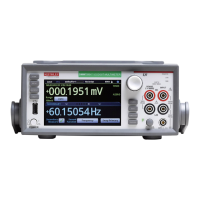7½ Digit Graphical Sampling Multimeter Reference Manual Section 3:
DMM7510-901-01 Rev. B / May 2015 3-111
Master node overview
You can assign the master node to any group. You can also include other nodes in the group that
includes the master. Note that any nodes that are set to group 0 are automatically included in the
group that contains the master node, regardless of the group that is assigned to the master node.
The master node is always the node that coordinates activity on the TSP-Link network.
The master node:
• Is the only node that can use the execute() command on a remote node
• Cannot initiate remote operations on any node in a remote group if any node in that remote group
is performing an overlapped operation (a command that continues to operate after the command
that initiated it has finished running)
• Can execute the waitcomplete() command to wait for the group to which the master node
belongs; to wait for another group; or to wait for all nodes on the TSP-Link network to complete
overlapped operations (overlapped commands allow the execution of subsequent commands
while device operations of the overlapped command are still in progress)
Group leader overview
Each group has a dynamic group leader. The last node in a group that performs any operation
initiated by the master node is the group leader.
The group leader:
• Performs operations initiated by the master node
• Initiates remote operations on any node with the same group number
• Cannot initiate remote operations on any node with a different group number
• Can use the waitcomplete() command without a parameter to wait for all overlapped
operations running on nodes in the same group
Assigning groups
Group numbers can range from zero (0) to 64. The default group number is 0. You can change the
group number at any time. You can also add or remove a node to or from a group at any time.
Each time the power for a node is turned off, the group number for that node changes to 0.
The following example code dynamically assigns a node to a group:
-- Assign node 3 to group 1.
node[3].tsplink.group = 1
Running test scripts and programs on remote nodes
You can send the execute() command from the master node to initiate a test script and Lua code
on a remote node. The execute() command places the remote node in the overlapped operation
state. As a test script runs on the remote node, the master node continues to process other
commands simultaneously.
Use the following code to send the execute() command for a remote node. The N parameter
represents the node number that runs the test script (replace N with the node number).
To set the global variable "setpoint" on node N to 2.5:
node[N].execute("setpoint = 2.5")

